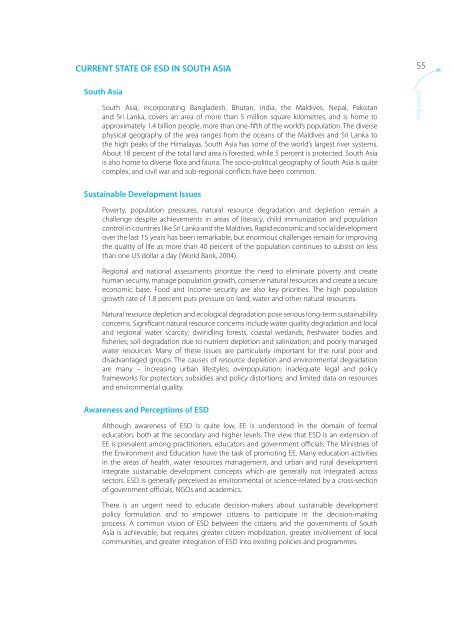A Situational Analysis - UNESCO Bangkok
A Situational Analysis - UNESCO Bangkok
A Situational Analysis - UNESCO Bangkok
You also want an ePaper? Increase the reach of your titles
YUMPU automatically turns print PDFs into web optimized ePapers that Google loves.
CURRENT STATE OF ESD IN SOUTH ASIA<br />
South Asia<br />
South Asia, incorporating Bangladesh, Bhutan, India, the Maldives, Nepal, Pakistan<br />
and Sri Lanka, covers an area of more than 5 million square kilometres, and is home to<br />
approximately 1.4 billion people, more than one-fifth of the world’s population. The diverse<br />
physical geography of the area ranges from the oceans of the Maldives and Sri Lanka to<br />
the high peaks of the Himalayas. South Asia has some of the world’s largest river systems.<br />
About 18 percent of the total land area is forested, while 5 percent is protected. South Asia<br />
is also home to diverse flora and fauna. The socio-political geography of South Asia is quite<br />
complex, and civil war and sub-regional conflicts have been common.<br />
55<br />
<br />
Sustainable Development Issues<br />
Poverty, population pressures, natural resource degradation and depletion remain a<br />
challenge despite achievements in areas of literacy, child immunization and population<br />
control in countries like Sri Lanka and the Maldives. Rapid economic and social development<br />
over the last 15 years has been remarkable, but enormous challenges remain for improving<br />
the quality of life as more than 40 percent of the population continues to subsist on less<br />
than one US dollar a day (World Bank, 2004).<br />
Regional and national assessments prioritize the need to eliminate poverty and create<br />
human security, manage population growth, conserve natural resources and create a secure<br />
economic base. Food and income security are also key priorities. The high population<br />
growth rate of 1.8 percent puts pressure on land, water and other natural resources.<br />
Natural resource depletion and ecological degradation pose serious long-term sustainability<br />
concerns. Significant natural resource concerns include water quality degradation and local<br />
and regional water scarcity; dwindling forests, coastal wetlands, freshwater bodies and<br />
fisheries; soil degradation due to nutrient depletion and salinization; and poorly managed<br />
water resources. Many of these issues are particularly important for the rural poor and<br />
disadvantaged groups. The causes of resource depletion and environmental degradation<br />
are many – increasing urban lifestyles; overpopulation; inadequate legal and policy<br />
frameworks for protection; subsidies and policy distortions; and limited data on resources<br />
and environmental quality.<br />
Awareness and Perceptions of ESD<br />
Although awareness of ESD is quite low, EE is understood in the domain of formal<br />
education, both at the secondary and higher levels. The view that ESD is an extension of<br />
EE is prevalent among practitioners, educators and government officials. The Ministries of<br />
the Environment and Education have the task of promoting EE. Many education activities<br />
in the areas of health, water resources management, and urban and rural development<br />
integrate sustainable development concepts which are generally not integrated across<br />
sectors. ESD is generally perceived as environmental or science-related by a cross-section<br />
of government officials, NGOs and academics.<br />
There is an urgent need to educate decision-makers about sustainable development<br />
policy formulation and to empower citizens to participate in the decision-making<br />
process. A common vision of ESD between the citizens and the governments of South<br />
Asia is achievable, but requires greater citizen mobilization, greater involvement of local<br />
communities, and greater integration of ESD into existing policies and programmes.

















